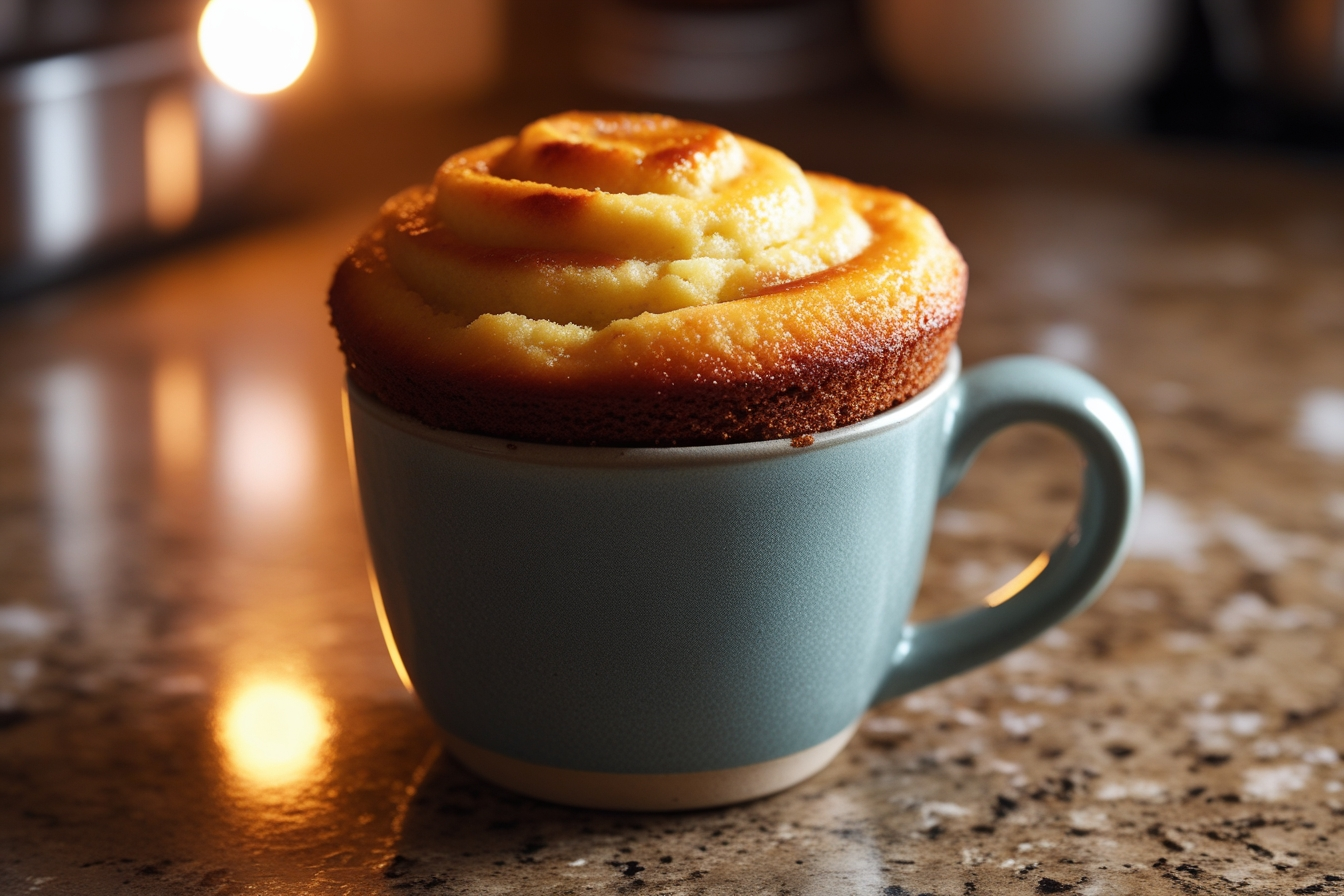Mug cakes have revolutionized home baking, offering a quick and easy solution for those sweet cravings. But, let’s face it—nothing is more disappointing than ending up with a dense or rubbery mug cake instead of the light, spongy texture you expected. Why does this happen? Well, several factors can make or break the fluffiness of your cake. In this article, we’ll dig into every nook and cranny of this issue, exploring causes and solutions so your mug cakes turn out perfectly every time.
Understanding Mug Cakes
Introduction to Mug Cakes
If you’re new to the concept, a mug cake is exactly what it sounds like—a mini cake baked in a mug, typically using a microwave. These single-serving desserts are a dream come true for anyone craving a homemade sweet treat without the hassle of traditional baking. They’re quick, fuss-free, and endlessly customizable. However, their simplicity can be deceptive; minor missteps in preparation can turn a delightful dessert into a disaster.
Whether you’re a novice baker or an experienced cook, mug cakes offer an opportunity to experiment. From chocolate chip classics to fruity variations, the possibilities are endless. But before diving into the solutions, let’s talk about the perfect spongy cake texture we’re aiming for.
Desired Texture: What Does ‘Spongy’ Mean?
A spongy mug cake isn’t just about being soft; it’s about the right balance of moisture, airiness, and structure. The ideal mug cake is light, springy to the touch, and moist enough to melt in your mouth. When the cake is dense, sticky, or dry, it fails to deliver that indulgent experience we all crave.
This texture depends on several factors, such as ingredient ratios, cooking time, and even the type of flour used. So, understanding the science of baking in a microwave is crucial. After all, baking is as much chemistry as it is an art!
Stay tuned as we move deeper into the common pitfalls that might be ruining your mug cakes and discover practical solutions to fix them.
Common Reasons for Non-Spongy Mug Cakes
Overmixing the Batter
Believe it or not, stirring your batter too much is one of the biggest culprits behind a dense, chewy mug cake. When flour is overmixed with liquids, gluten—a protein that gives bread its structure—develops excessively. While some gluten is necessary for structure, too much of it makes your mug cake stiff and far from the soft, spongy texture you’re hoping for.
To avoid this, mix the ingredients just until they are combined. The batter should appear lumpy but uniform, with no streaks of dry flour. Overmixing might feel tempting, especially if you want a smooth texture, but trust us—your mug cake will thank you for showing restraint!
Incorrect Ingredient Measurements
Mug cake recipes are small by nature, and even slight errors in measurement can throw off the entire texture. Adding too much flour makes the batter thick and dry, while too little liquid results in a cake that’s not moist enough to be fluffy. The tiny scale of the recipe leaves very little room for error.
For best results, measure your ingredients with precision. Use measuring spoons for small amounts like baking powder and liquids. When working with flour, scoop it lightly into the measuring cup and level it off—packing flour tightly can lead to excess amounts and a dense cake.
Using the Wrong Type of Flour
Not all flours are created equal, and the type you use can significantly impact the outcome of your mug cake. Self-rising flour contains a built-in leavening agent that helps the cake rise and maintain a spongy texture. On the other hand, all-purpose flour requires the addition of baking powder or soda to achieve similar results.
If you’re in a pinch and only have all-purpose flour, mix in 1/4 teaspoon of baking powder for every three tablespoons of flour used. This simple adjustment ensures your mug cake will puff up nicely in the microwave.
Insufficient Leavening Agents
Leavening agents like baking powder or baking soda are essential for creating those air pockets that give cakes their fluffiness. Without them, your mug cake might remain flat, dense, or even soggy. Using too little or forgetting it entirely is a common mistake.
To ensure a proper rise, double-check your recipe and confirm you’ve added the right amount of leavening. If your baking powder is old, it may have lost its effectiveness. A quick test—dropping a pinch into a small bowl of water—can determine if it’s still active. If it bubbles, you’re good to go!
Overcooking in the Microwave
It’s easy to overshoot the cooking time in a microwave, leaving your mug cake dry and crumbly. Microwaves heat unevenly, and even an extra 10 seconds can zap all the moisture out of your cake, turning it into a rubbery disappointment.
To prevent overcooking, start with the shortest recommended cooking time in the recipe, usually about 60-90 seconds. Check the cake’s doneness by poking the center with a toothpick; if it comes out clean, stop cooking. Remember, the cake will continue to cook slightly from residual heat after the microwave turns off.
Incorrect Mug Size and Shape
Surprisingly, the mug you choose plays a pivotal role in determining the texture of your cake. A mug that’s too small can cause the batter to overflow, while one that’s too wide may lead to uneven cooking. The height and shape of the mug also affect how the heat distributes.
Choose a microwave-safe mug with a capacity of about 12-16 ounces for best results. This size allows the batter to rise without spilling and ensures even cooking throughout.
Ingredient Temperature Issues
Using ingredients straight from the fridge can throw off your mug cake’s texture. Cold ingredients, especially eggs and milk, can prevent the batter from mixing evenly. This inconsistency leads to pockets of undercooked batter or a cake that doesn’t rise properly.
To avoid this, let your ingredients come to room temperature before mixing. If you’re short on time, you can warm up cold milk slightly in the microwave for a few seconds—just don’t overdo it.
Excessive Oil or Fat
While fat is essential for a moist and tender cake, too much of it can backfire. Overloading your batter with oil or butter can lead to a greasy, heavy cake that lacks the desired spongy texture. The excess fat weighs down the batter, preventing it from rising properly.
Stick to the recommended amount of fat in your recipe. If your batter seems excessively oily, you can balance it by adding a touch more flour or liquid. Small adjustments can make a big difference!
Techniques to Achieve a Spongy Mug Cake
Proper Mixing Techniques
Mixing might seem like a minor step, but it holds the key to achieving that light, spongy texture. Overmixing, as we’ve discussed, can make your mug cake dense, but under-mixing can leave you with unblended pockets of flour or other ingredients.
To strike the perfect balance, stir the batter gently and only until all ingredients are just combined. Use a fork or a small whisk to ensure an even mix without overworking the gluten. Sifting dry ingredients like flour and cocoa powder beforehand is another excellent strategy; it helps eliminate lumps, making it easier to achieve a smooth batter without excessive stirring.
Accurate Measurement Practices
Precision is everything when working with single-serve recipes like mug cakes. The small quantities of ingredients mean even a slight miscalculation can throw off the texture. Too much flour leads to dryness, while too little baking powder leaves your cake flat and lifeless.
Use proper measuring tools—spoons for dry and liquid ingredients and cups for larger amounts. For sticky ingredients like honey or syrup, lightly grease the measuring spoon to ensure every last drop makes it into the batter. This tiny step can help maintain the right balance of sweetness and moisture.
Selecting Appropriate Ingredients
The choice of ingredients directly impacts the outcome of your mug cake. Using self-rising flour simplifies the process by incorporating leavening agents, but if you’re using all-purpose flour, be sure to add the right amount of baking powder. Eggs provide structure and richness, but overusing them can make the cake rubbery.
Dairy products like milk enhance the cake’s tenderness, and plant-based alternatives can work too if they’re well-suited for baking. For those watching their fat intake, replace a portion of the oil with unsweetened applesauce—it keeps the cake moist while reducing heaviness.
Optimal Microwave Settings
Microwave wattage can vary, and a one-size-fits-all approach doesn’t always work for mug cakes. Cooking at full power might be tempting, but it often leads to uneven cooking, with the edges overdone and the center undercooked.
Instead, use medium power (about 70-80%) and cook in short intervals, checking the cake’s progress along the way. Starting with 60-90 seconds is a good rule of thumb. If you’re unsure, stop the microwave when the edges look set but the center is slightly soft—it will finish cooking with residual heat.
Experimenting with Add-ins and Flavors
The beauty of mug cakes lies in their versatility. Adding chocolate chips, nuts, or dried fruits can elevate both the flavor and texture. Chocolate chips, for instance, melt into gooey pockets of deliciousness, while fruits like berries add moisture and a burst of flavor.
When using add-ins, fold them into the batter gently to avoid overmixing. Keep quantities modest, as too many heavy ingredients can weigh down the cake. A pinch of cinnamon or a drop of vanilla extract can also add a surprising depth of flavor without altering the texture.
Conclusion
Summarizing Key Points
Achieving the perfect spongy mug cake is as much about precision as it is about creativity. From avoiding overmixing to using the correct ingredients, every step in the process contributes to the final texture. Remember, even seemingly small factors like microwave wattage or mug size can have a big impact on your results.
To recap, measure your ingredients carefully, mix them gently, and pay close attention to cooking times. Selecting the right flour and leavening agents, and ensuring your ingredients are at room temperature, can make a world of difference. Finally, don’t shy away from experimenting with flavors and add-ins—they can elevate your mug cake from a simple dessert to something truly special.
Baking is all about trial and error, so don’t be discouraged if your first attempt doesn’t turn out perfect. With practice and the tips in this guide, you’ll soon master the art of making light, fluffy mug cakes that hit the sweet spot every time. Enjoy the process, and most importantly, savor every bite!

